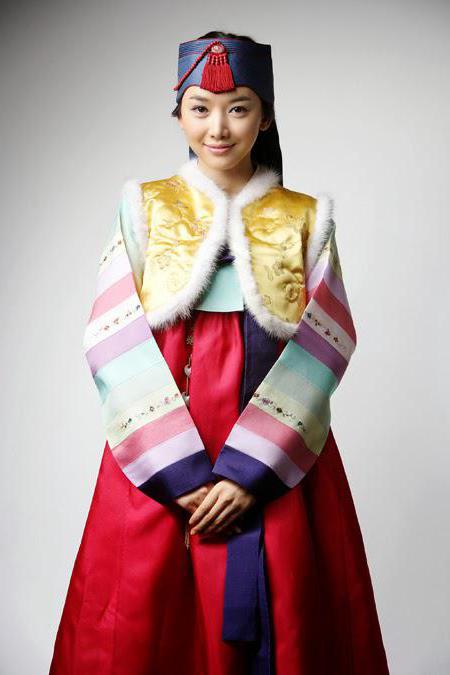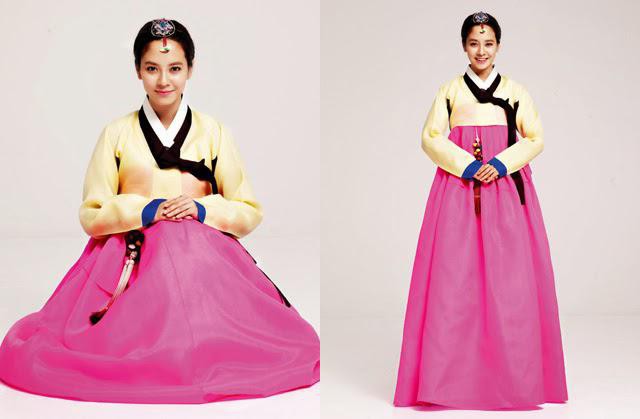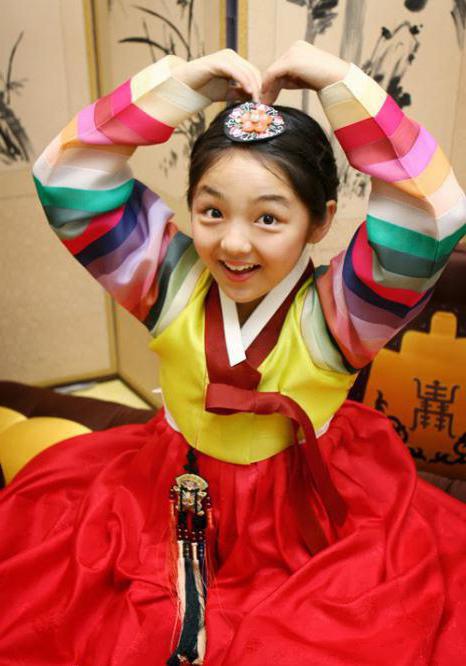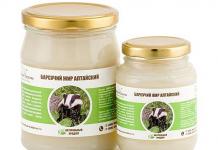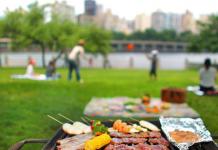The most unusual way to spend the night in Korea is to take advantage of the Temple Stay program and live in a Buddhist monastery like an ordinary novice. Every year more and more people prefer this type of accommodation, which allows them to literally plunge into the local specifics. Despite the fact that this is a very facilitated obedience in a religious sense, living in a temple in ...
In Korea, you can spend the night not only in a standard European-style hotel, but also in a traditional Korean house "hanok". These are low wooden houses, standing on stone supports, with a tiled roof with upward curved corners. There is usually a small courtyard behind a high stone wall in front of a dwelling. Noble and wealthy Koreans used to live in hanoks, then ...
The famous martial art of taekwondo (taekwon-do, 태권도) is famous for being ancient and native Korean. However, its antiquity is greatly overestimated. The art of taekwondo was finally formed only in the 60s and 70s of the twentieth century. Of course, martial arts such as tekkyon, thesudo, subak and charyok have long existed in Korea, but they have very little to do with taekwondo. And the Koreanness of taekwondo by many ...
Not far from Suwon, you can visit the Korean Folk Village (or Folk Village). It is less authentic and traditional than Andong, but much more affordable and popular due to its proximity to Seoul. In the Folk Village, you can plunge into the life, history and culture of Korea. Various shows and performances are constantly held on the territory of the village - the most popular are folk dances, ...
By far the main holiday in Korea is Seollal (설날), the Korean New Year. It has no fixed date. Seollal is celebrated on the first day of the new year by lunar calendar, which usually falls at the end of January - mid-February. Seollal is the first day of spring in the Korean lunar calendar. Celebrating the "Eastern" New Year (aka "Chinese ...
Christmas is celebrated in Korea on December 25, and Christmas is celebrated in South Korea on January 1 New Year... These are non-working holidays. New Year in South Korea is not as popular a holiday as Seollal (Korean New Year, which is celebrated according to the lunar calendar in late winter or early spring) or Chuseok, but nevertheless ordinary Koreans enjoy the extra ...
One of the main Korean holidays is Chuseok (추석). It is celebrated according to the lunar calendar, that is, it has a "floating" date - the fifteenth day of the eighth lunar month (falls on September-October). Chuseok is a harvest festival. Sometimes it is translated as "Thanksgiving Day" (the American trend, apparently), although, of course, it has nothing to do with the American holiday, but in fact it turns out right. ...
Despite recent changes, the traditional Confucian structure of social relations still largely determines the behavior of Koreans.
Respect for elders
Age and social status are of great importance. It is believed that those who are younger in age or lower in social status are obliged to follow the wishes of their elders without objection. Therefore, in Korea, people are often interested in a person's age, marital status in order to determine their position in relation to this person. These questions are not asked out of idle curiosity. However, you do not have to answer them if you don’t want to.
Names
The most common Korean surnames are: Kim (21% of all Koreans), Lee (14%), Park (8%), Choi (or Choi), Chon, Chan, Han, Lim, etc. A Korean given name consists of a surname mainly of one syllable and a given name itself usually of two syllables. The last name comes first. Women in Korea do not take their husband's surname after marriage, however, their children carry the father's surname.
Marriages
In Korea, marriage is traditionally considered the most important event in life, and divorce is a shame not only for former spouses but also for their families. Despite this, the divorce rate has been on the rise lately. The modern wedding ceremony is somewhat different from the traditional one. First, a Western-style ceremony is arranged in the wedding palace or in the church. On it, the bride and groom are dressed respectively in a tuxedo and a wedding dress. Then, on the same day (and usually at the same location), a traditional wedding ceremony is held in a separate room, during which the young are dressed in traditional Korean costumes.
Chere (rite of remembrance of ancestors)

According to traditional Korean beliefs, when a person dies, his soul does not immediately go to another world, but only after the change of four generations. All this time, the deceased is considered a member of the family. On holidays such as Sollal (Lunar New Year) or Chuseok (Harvest Day), as well as on the day of the death of the deceased, his descendants perform a rite of remembrance. Koreans believe they can live happily thanks to the care of their departed ancestors.
Rules of conduct and gestures
Koreans attach great importance to greetings and words of gratitude. They are always pronounced with a slight bow. The depth of the bow depends on the relative position of the speakers. Koreans don't like being overly emotional and usually restrict direct physical contacts a polite handshake. However, as your relationship grows closer, more familiarity may appear.
Foreigners in Korea are often surprised to see girls walking hand in hand. Touching between people of the same sex who are in close friendships is perfectly acceptable in Korea. Public displays of affection between different genders, such as kissing and hugging, are not as rare these days as they used to be, but they continue to be considered obscene.
Traditionally, Koreans sit, eat and sleep on the floor. Therefore, it is always necessary to take off your shoes when entering a Korean home. In Korea, it is considered indecent to be bare-legged in the presence of elders, so it is recommended that you always wear socks or stockings when visiting a Korean family.
Among the younger generation of Koreans, it is considered quite normal to pay a bundle, but it often happens that someone from a group of friends or colleagues pays the bill. It used to be considered impolite in Korea to talk while eating, but nowadays it is permissible to talk and laugh at the table.
Thank you for Tasty food and good service is always welcome. It is considered indecent to blow your nose at the table.
In Korea, it is not customary to call a person with a palm facing up or beckon with a finger.... In Korea, dogs are usually called with such gestures. If you want to beckon a person, do it with your hand with the palm facing down.
Hanbok
For millennia, hanbok has been the traditional dress of Koreans. The beauty and grace of Korean culture is beautifully captured in photographs of Korean women wearing hanbok. Prior to the introduction of Western-style clothing in Korea about 100 years ago, hanbok was the everyday clothing of Koreans.
Men wore chogori (jacket) and paji (trousers), while women wore chogori and chhima (skirt). These days, Hanbok is only worn on special occasions and holidays such as wedding day, Sollal (Lunar New Year) or Chuseok (Harvest Day).
Ondol
Rooms in a traditional home do not have a clearly defined purpose. For example, there are no rooms that are used as, say, a dining room or bedroom. Depending on the need, the same room can be used both as a dining room (in this case, a small folding table is placed there) and as a bedroom (in this case, a mattress is laid in the room).
Most Koreans prefer to sit and sleep on the floor on special mats or mattresses. The rooms in the Korean house have a special heating system. ondol built into the floor. Previously, rooms were heated by hot air that circulated through pipes in the clay floor. Today, hot water heating is used: hot water circulates through pipes embedded in a cement floor covered with linoleum or other material.
Gimjang
Gimjang is a centuries-old tradition of harvesting kimchi for the winter, passed down from generation to generation. Various pickled vegetables (mainly collard greens), called kimchi in Korea, are harvested for future use in late autumn. It is simply impossible to imagine a Korean table without this dish.
Oriental medicine
In oriental medicine, it is believed that all diseases are caused by a decrease vital energy and weakening of the body's immune system, i.e. not a dysfunction of any particular organ, but an imbalance of vitality in the body as a whole. Therefore, oriental medicine strives to treat diseases by strengthening the immune system and restoring harmony in the body, and not by eliminating pathogenic factors.
The main methods of oriental medicine include herbal therapy, acupuncture (acupuncture), moxibustion, and cupping.
Traditional art
Dance
Jinju gommuAs in music, there is a division between court and folk dances. Common court dances are jeongjemu performed at banquets, and ilmu- during the Confucian rituals. Jeonjemu are divided into primordial ( hyangak jeongjae) and those who came from Central Asia and China ( tangak jeongjae). Ilmu are divided into civil ( munmu) and military ( Mu Mu). Many costume performances or dances are performed in different parts of Korea. The traditional dress for dancing is genja, a special dress. worn during festivals.
The traditional choreography of court dances is reflected in a variety of contemporary productions.
Painting
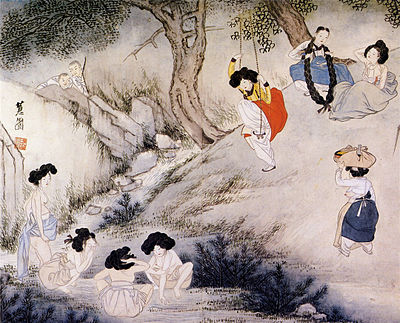
Scene of the day Tano
Main article: Korean painting
The earliest paintings found on the Korean Peninsula are prehistoric petroglyphs. With the penetration of Buddhism from India through China, various other techniques appeared in the country. They quickly became mainstream, although local techniques survived and developed further.
Naturalism has become a popular trend in painting with such motives as realistic landscapes, flowers and birds. Most of the paintings are done in ink on mulberry paper or silk.
In the 18th century, local techniques advanced greatly, mainly in calligraphy and stamp engraving.
During the Joseon period, porcelain items decorated with blue designs were popular. At the same time, woodworking developed, leading to elaborately crafted furniture such as dressers, wardrobes and tables.
Ceramics

Goryeo Dynasty Celadon Incense Burner
The use of pottery in the Korean Peninsula dates back to the Neolithic. The history of Korean ceramics is long and includes the creation of early ritual and decorative items. During the Three States period, pottery flourished in Silla. Earthenware was treated with a special fire, which led to the formation of a specific gray-blue celadon color. The surface was decorated with a variety of geometric patterns.
During the Goryeo period, jade green celadon products became popular. In the 12th century, new inlay techniques were developed, allowing the creation of more sophisticated decorations in different colors. Evelyn McCune writes: “In the 12th century, pottery production reached its perfection. Several new species have appeared in a quarter of a century, one of which, inlaying, can be considered a completely Korean discovery. " Neither China nor Japan produced inlaid celadon, which is unique to Koryo's wares.
White porcelain became popular in the 15th century. It soon became more popular than celadon. White porcelain was often decorated or painted with copper.
In the late Joseon period ( end of XIX century) became popular blue and white porcelain.
Customs
Architecture
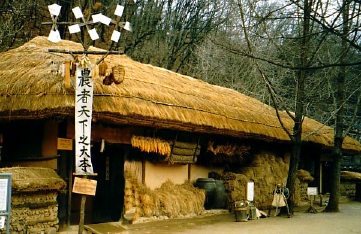
Traditional peasant house
Habitats are traditionally chosen using geomancy. Although geomancy has been a vital part of Korean culture and shamanism since prehistoric times, geomancy later re-entered Korea from China during the Three State Period.
The house should be built against a hill and facing south to get as much sunlight as possible. This arrangement of houses is popular in modern Korea as well. Geomancy has also influenced the shape of buildings, their placement and the choice of materials.
Traditional Korean houses are organized into an inner wing ( anche) and outer wing ( locust). The specific layout depends on the region and the wealth of the family. While aristocrats use the outer wing for receptions, poorer people keep livestock in it. The more wealth the family has, the larger the house. At the same time, it is forbidden for any family to have a house over 99 can except for the king. Kahn- the distance between two supports used in traditional houses.
The inner wing usually consists of a common room, kitchen and hall with wooden floors. More rooms can be connected in it. Poor peasant families may not have an outer wing. Heated floors ( ondol) have been used in Korea since prehistoric times. The main materials used in construction are wood, clay, tiles, stone and straw. Due to the use of wood and clay in the past, few old buildings have survived to the present day. People nowadays usually live in apartments and more modernized dwellings.
The oldest and most famous of the monuments of Korean architecture is the Gyeongbokgung Palace in Seoul ("the palace of sunshine and happiness"), built in 1394. The palace complex is divided into several parts, pavilions. The private quarters of King Taejo (reigned 1392-1398), the founder of the Joseon Dynasty, were located around the Gyeongjeongjong throne room. One of the pavilions, Gyeonghweru, is located in the center of the lotus pond.
Gardens
Main article: Korean garden
The principles for building both temple and private gardens are the same. Shamanism influenced mainly the style of the gardens. Shamanism is associated with nature and mysticism and stands out for its utmost attention to detail in the landscape. Unlike the gardens of China and Japan, which contain elements made by people, in Korean everything artificial is avoided, the gardens try to look even more "natural" than nature itself.
The lotus pond is an important feature in a Korean garden. If there is a real stream in the garden, then a pavilion is usually built nearby, allowing you to enjoy watching the water. Multilevel flower beds are also common.
Phoseokchon near Gyeongju was organized during the Silla period. It highlights the importance of water in traditional gardens. At the end of the Silla state, the king's guests sat along the riverbed and chatted while bowls of wine floated between them.
Outfit
 Khvarot, bride's outfit
Khvarot, bride's outfit
Traditional Korean costume known as hanbok(한복, 韓 服) (or chosonot in the DPRK), worn since ancient times. Hanbok consists of a blouse (
European culture is fundamentally different from Asian culture. This manifests itself in absolutely all social and everyday nuances, which is why Asia is incredibly attractive for tourists from all over the world. Of particular interest is the culture and customs of South Korea, which for a long time was in some isolation from the rest of the world. Today Europeans find this country incredibly beautiful and distinctive, so we decided to tell you the most Interesting Facts about the culture of Koreans.
Korean culture: features
At the beginning of the article, I would like to clarify that Koreans are an indivisible nation with common traditions, religion and customs. But due to certain circumstances, the country was divided into parts and now represents two absolutely sovereign states - South and In cases where journalists or sociologists mention Korea, they mean exactly a state called South Korea. We will do the same. Moreover, cultural heritage both countries is identical.
South Korea: customs and traditions
Korean culture was shaped by the influence of the Chinese and Mongolian people. This can be traced to some elements of folk costume and musical preferences, surprisingly reminiscent of traditional Chinese chants. If you ever find yourself in Korea, you will be surprised how often music and songs are heard on the streets of cities. They accompany the life of an ordinary Korean from birth to death.
Religion has greatly influenced the cultural traditions of Korea. Initially, almost all Koreans were ardent adherents of shamanism. Only with the arrival of the first Buddhist monks from China to these lands, a new religion began to spread across the country. She surprisingly quickly entered the life of Koreans and superimposed on their traditions. In addition, Buddhism gave a powerful impetus to the development of art. Traditional painting, for example, under the influence of a new religion, has been enriched by previously unused styles and trends. Painting on silk and paintings in the style of naturalism became popular.
In the culture of Asian peoples, a special place is occupied by the attitude towards the older generation. This tradition can be attributed to Koreans as well. Among them, it is still customary to treat elders with great respect and carry out their words without reservations. Quite often, being among strangers Koreans are eager to find out their social status and age. It is from this that they start off, building a model of behavior in society.
Korean marriage: how is it?
Young Koreans respect the will of their parents above all else and do not marry until after their blessing. Indeed, in Korea, divorce is considered a shame not only for two people, but also for their families. Nowadays, weddings are played mainly in two versions - traditional and Western style. Thus, all secular laws and cultural traditions are respected. The most common clothing at any festive ceremony is the Korean national hanbok costume. It inspires admiration among Europeans because this clothing is a riot of colors and simplicity of lines, which together add up to an incredibly attractive image.
Korean folk costume: general characteristics
The costume, which is the national festive dress in Korea, is called hanbok. It has remained practically unchanged for several millennia. Korean has three main parts:
- chogori;
- chhima;
- open up.
Chogori is the top shirt, chhima is the A-shaped skirt, and the open ones are wide and long ribbons that prevent the shirt from swinging open and are a decorative element of the costume.
Korean men's suit consists of the following elements:
- chogori;
- paji;
The chogori top shirt in a man's suit differs little from a woman's, and paji pants are comfortable baggy trousers tied with two ribbons, which makes them almost universal. In the cold season, a kind of coat - pho - was worn on the chogori.
Hanbok color scheme
In various catwalk photos, the Korean national costume appears to foreigners as something surprisingly colorful. Koreans know how to combine bright and rich colors with each other to create unique looks. Usually in one suit two or three colors are used in extraordinary combinations. Chhima and chogori were often decorated with gold foil embroidery, which was elevated to the rank of a special art in Korea.
The bright colors of hanbok have always been available only to noble Koreans. They had the right to use all sorts of colors, which often played an informational role when meeting with friends. For example, deep blue color could only be worn by women with one son.

Commoners were forbidden to use bright colors: their Korean national costume was replete with shades of gray and beige. On holidays, the poor could afford some color variety - pink and green. But she always had very pale shades in contrast to the pure and rich colors of the hanbok of the aristocrats.
What material was the Hanbok made of?
The Korean national costume was most often sewn from blended cotton fabrics. They were perfectly worn in the hot season; in other seasons, their silk clothes were common. But only the rich could afford such a variety. The general population of Korea wore a simple cotton or hemp hanbok.
Female Hanbok: Details
It should be noted that over the entire history of its existence, the folk costume has changed only its length and design elements. In general terms, he remained whole, which speaks of his extreme convenience, which Koreans are proud of to this day. The chogori top shirt has always been quite short, in the traditional version it reaches the waist. But at different times its length changed significantly. For example, in the eighteenth century, chogori turned into a kind of top, barely covering the chest. In some provinces, it even left the breast not closed, which indicated that the woman had children.
Chhima, too, did not always have the current bell shape. Influenced by Mongolian and Chinese culture, the skirt from the seventeenth century began to widen towards the hips and narrow towards the legs. In the nineteenth century, this form of chhima reached its maximum expansion and gradually began to acquire more traditional look... Now the skirt of the national costume starts just under the bust and expands towards the floor. Opened ribbons were initially very narrow, but over time they began to be made from fabrics that were contrasting with the color of the chogori, in order to create an additional design element from them.
Hanbok: suit for men
Hanbok for men has barely undergone major changes. Chogori and paji were often sewn from fabrics of different colors, which made it possible to create unique combinations and combinations. In a men's suit, the chogori reaches mid-thigh and has a loose fit, in contrast to the fitted women's version.
As outerwear, men often wore not only the already mentioned pho, but also magoju - and a detachable collar. It was customary to wear it over the chogori and not fasten it. This piece of clothing came to Korean culture thanks to the Mongolian princesses. But a few years later, it merged so much with the traditional hanbok that to this day it is considered the main part of the national costume of not only men, but also women.
Children's traditional clothes
Korean national costume for girls and boys is not much different from adult models. Parents are trying to purchase suits of bright colors for their beloved children, which are worn not only on official public holidays, but also in a close family circle. It is also customary to wear hanbok to various festive events in kindergarten and school.
It is difficult to imagine at least one celebration in Korea that would have done without a national costume. Absolutely all Koreans love him, without exception. And this is not surprising because, in addition to beauty, hanbok is distinguished by its extraordinary convenience and practicality. Therefore, if you happen to visit South Korea, be sure to bring a hanbok from there as a souvenir. With it, you can make an unforgettable impression at any party.
Major holidays in Korea
January 1st | New Year |
March 1 | Independence Movement Day This day is celebrated in honor of the Declaration of Independence against Colonial Japan, proclaimed on March 1, 1919 .... |
April 5 | Seollal |
5 May | Children's Day On this day, parents dress up their children in their best clothes and take them for a walk to parks, various attractions, zoos, etc. |
May 15 | Buddha's birthday |
June 6th | Memorial Day |
July 17th | Day of the proclamation of the constitution |
August 15 | South Korea Independence Day |
October 3 | Founding of Korea |
October 9 | Korean Writing Day |
December 25 | Catholic Christmas |
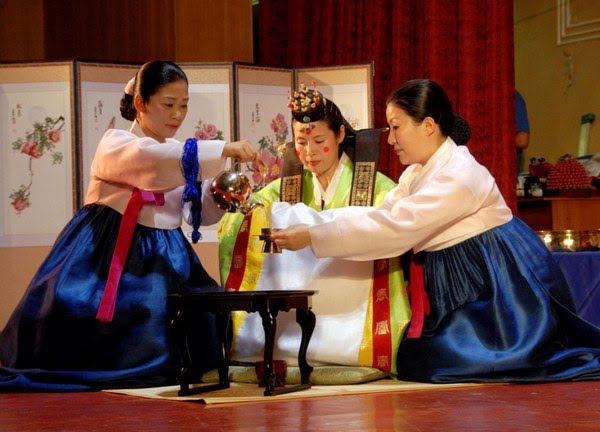
Chuseok
■ Chuseok is a holiday of thanksgiving to the ancestors.
Chuseok is celebrated on August 15th according to the lunar calendar and is one of the 3 most important and popularly celebrated holidays in Korea ("Solnal" is the New Year according to the lunar calendar, "Tano" is the Spring Festival celebrated on May 5th and of course the Thanksgiving holiday of the ancestors for a new harvest - "Chuseok").
Other names for Chuseok are Hangawi and Junchuchol. For the Chuseok holiday, all family members gather and together with relatives eat cooked food made from the new harvest, paying tribute to the ancestors and asking for a bountiful harvest next year. This year, Chuseok falls on September 18th. But this holiday is usually celebrated for three days: one day after and one day after, therefore September 17, 18, 19 are considered public holidays in Korea.
■ Traditional Chuseok rituals
In the morning, at dawn, the table is set at home, food from the products of the new harvest is placed on the table, including the Songpyeong rice cakes, as well as a glass of alcoholic beverage. After the "Chare" rite is over, they climb the mountains (since the graves in Korea are located mainly in the mountains). On this day, the graves are cleaned and cleared of weeds (according to Korean tradition, it is not allowed to often go to the grave to the deceased, disturbing their peace, therefore, coming there from time to time it is necessary to put things in order). The ceremony of cleaning the grave is called "Bolcho". And after pulling out the grass at the grave, thanksgiving obeisances are presented to the ancestors, which are called "Solmyo".
Here are three main ceremonies through which people show their gratitude to their ancestors for the new harvest. And when evening comes, everyone gathers in a circle and under the round moon they dance the Kankansulle folk dance and play various national games.
■ The main course is Chuseok Rice Cakes "Songpyeong".
No Chuseok is complete without Songpyeong rice cakes. The dough is kneaded from rice flour, then small pieces are torn off the dough and stuffed with a sweet filling of beans, sesame seeds and chestnuts. Then crescent shaped and steamed with pine needles, pine needles are placed to give the Songpyeong rice cakes a pine flavor. It is said that a girl who prepares a pretty crescent-shaped "Songpyeong" bread will marry well. Whether because of this, or for some other reason, everyone is trying to make beautiful Songpyeong.
■ Traditional dance "Kankansulle" in Chuseok
The history of this dance goes back to the time when there was a war between Korea and Japan in 1592. The commander Lee Sung-shin ordered the women to change into men's military uniforms and surround the mountain, hoping thereby to mislead the Japanese, who could mistaken women for the Korean army from afar and thereby miscalculate the forces of the Koreans. That battle, Lee Sung-shin won a victory with a good strategic plan. Since then, this dance has appeared, which has become a folk dance. Girls wear beautiful national dresses "Hanbok", holding hands and forming a circle singing: "Kankansulle, kankansulle ...."
■ Where can you go in Chuseok?
At the Kogun Palace, in the national Korean village of Hangukminseokchon, in the national village of Namsangol Hanok-maul, various events will be held during Chuseok. Hangukminseokchon National Korean Village will host a performance from September 17th to 19th, which will reproduce ancient traditional rituals and will also host folk festivities. In the national village "Namsangol Hanok-maul" also from the 17th to the 19th there will be a demonstration of national customs, they will show how to make rice cakes "Songpyeong", how to set the thanksgiving table to the ancestors "Chare-san", the thanksgiving table to the ancestors "Charigi "(This is how the thanksgiving table to the ancestors is laid in the Cholado and Gyeongsang provinces) and various festivities and games.
In the palaces "Gyeongboggun", "Changyeonggun", "Chandoggun" will also be held festivities and folk performances.
The holiday begins in the early morning with the rite of sacrifice to the ancestors, who are given the right to be the first to taste tteok and vodka from rice of the new harvest, as well as fresh fruits: persimmons, chestnuts, jujuba, nuts, ginkgo fruits, quince.
After having a bite, the people go to the ancestral cemetery - to the graves that have been put in order in advance. Traditional dishes for this day: songpyeong - green and white rice cakes like dumplings with the addition of white unleavened or red sweet beans, chestnuts. On the days of the holiday, Koreans consume large quantities of pekchu vodka made from rice of the new crop. In Chuseok, it was considered a good sign if one of the guests, after getting drunk, could not get up or even fall asleep at the table. Maybe this is where Koreans' current tolerance for drinkers comes from. In Chuseok, it was necessary to taste chicken meat. One of the wonderful events in Korean life, which fills the hearts of people with joyful expectations on the eve of Chuseok, is the bonuses and holiday payments (bonuses) that firms and enterprises generously present to their employees.
Enjoy triple fun at Chuseok!
Chuseok is a great time for relaxation, entertainment and shopping. On this biggest Korean holiday, Seoul and many provincial locations host a variety of events, and malls, including duty-free shops, are busy serving shoppers for the holiday sale. You can experience all this yourself by coming to Korea now. But do not forget to think over the program of your trip first. Hurry up to familiarize yourself with Korean traditions and enjoy shopping in the latest fashion!
Step 1. "Chuseok" and its traditions
Like Solnal (Lunar New Year), Chuseok is Korea's most significant holiday, held on August 15th. On this day, also called Junchu or Hangawi, Koreans dress up and spend a ritual of ancestor worship, serving "tok (rice cakes)" and vodka made from freshly harvested rice. After this ceremony, Koreans go to the cemetery or rest with their families. Chuseok is the most abundant holiday, and it's not for nothing that people say: "Let life be no better and no worse than on Hangavi." Traditional dish The holiday is said to be made from fresh rice, peas and chestnuts, "songpyeon". The abundance of only ripe chestnuts, persimmons, apples and other fruits warms the souls of all Koreans on this holiday. In the villages on Chhusok, round dances ("gangansulle"), traditional games ("sajanori", "djuldarigi") are played and parties are held.
Step 2. An abundance of traditional games
Chuseok hosts traditional Korean games and events at many locations in Seoul. In all places associated with traditional culture, including ancient palaces, there are always some kind of performances. These days, having found out the date and place of the event, it is good to participate in competitions and concerts, which are held free of charge. Mask dances, traditional weddings, festive “tok” cooking, traditional games - everything that is not easy to see on ordinary days - will leave an unforgettable experience in your memory.
Step 3. Sale plus gifts
On Chuseok, you can buy branded items in duty-free shops at a discount of up to 70-80%. In addition, you can take part in various contests and receive gifts. Of course, this does not mean that you should buy things you do not need and ruin the whole trip with it. In order to get the most out of your trip, you need to know the information you need in advance and make smart purchases.
Before traveling to Korea, be sure to check the internet duty free. Thus, you can save time by thinking over the list of things that you would like to purchase in advance. In addition, this way you can save yourself from unnecessary purchases and calculate your finances. In order to make a purchase on the Internet, you first need to register on the site, and then order the product you need. Please note that payment is made by credit card, and when buying an expensive item, it is better to see it yourself first.
Duty free shopping at the airport
In order to safely go shopping at the airport duty-free, you need to register in advance. First of all, do not forget the Duty Free catalog. The store at Incheon Airport is very large, so it's best to check out the goods first and shop later. Dutyfree Lotte at Incheon Airport mainly sells cosmetics, perfumes, clothes and watches, Dutyfree AK - cosmetics, Sony, Phillips and other electrical goods. Dutyfree NOTK has a Korean department, where, in addition to branded items, cigarettes, ginseng and kimchi are sold, Australian department , which sells products from sheep six, as well as various seasonal sales departments. However, the sale can be in certain departments, so you need to shop by comparing prices with city duty free shops.
Shopping in city duty free
While walking around Seoul, you can shop at city duty-free shops. Knowing the features of each store, you can buy a thing without spending a lot of time on it. City duty-free are located mainly in the city center, hotels, parks, which allows you to combine tourism with shopping. For example, when shopping in Myeongdong, you can drop by Lotte department store and Lotte Dutifree department store.

Korean new year
The New Year's holiday lasted the entire first half of the 1st lunar month: it began with the appearance of the crescent of a new moon and ended at the full moon of the 14-15th day. His first and last days were especially intense.
In the New Year's holiday of Koreans, like many peoples, the magic of the 1st day played an important role. The first day of the New Year's holiday was celebrated especially solemnly and cheerfully, as they believed that the first day would be the same throughout the year. The Koreans had a belief: "The more fun we celebrate the New Year, the richer the new harvest will be." Therefore, on this day, festivities, mass games, and sports competitions were organized.
Elements of jokes and games were observed in New Year's rituals. On the island of Yiju, young men and women organized competitions in eating sweets. There was also a custom at dawn to eat raw chestnuts, ginkgo fruits, gnaw walnuts and unpeeled pine nuts, repeating the wishes: "All year, all twelve months, live without worries and not know any diseases!" Gnawing nuts was believed to strengthen teeth and prevent dental diseases. There was a New Year joke - "sale of heat". We tried to get up as early as possible and call out to someone. If he responded, they immediately shouted: "Buy my heat!" It was believed that if you sell heat in this way, you will not get heatstroke. Therefore, on the morning of the 14-15th day, no one responded to the call. The peasants, to the sound of drums and bronze cymbals, singing a cheerful song, walked around the houses and wished the owners happiness in the new year. In every house they were treated.
On New Year's celebrations, clergymen also bypassed houses: monks, shamans and shamans, fortune-tellers. Buddhist monks left the monasteries and walked around the surrounding villages. They went from door to door and, to the beat of a drum, chanted the prayer "Namuamittabu", while distributing cakes made in the monastery. The owners of the house in exchange for a flat cake gave them two flat cakes, rice or money. It was believed that if a child ate a cake received from a monk, he would not get smallpox. The monks also made sacrifices to the spirits of the five parts of the world, for which they went into houses, where they also pronounced New Year's greetings and prayers. For this they took out a little rice, and the monks assured that the people who donated it would be happy all year round. Sometimes the monks stopped in the street and read prayers to the beat of a drum, and people threw coins at them. Shamans-mudan and shamans-pansu went from house to house, for a small fee they wondered about the upcoming fate of their inhabitants, performed cleansing rituals and prayers for the well-being of family members. The meeting of the first full moon in the new year, which fell in the middle of the month, was accompanied by bright rituals. At dusk, when the silver glow in the eastern sky signified the beginning of the full moon, large groups of people climbed to the top of the mountains to meet the moon, and when it rose, they all prostrated on the ground in front of its radiant face. This traditional worship of the moon has long roots and is associated with the ancient games under the moon. In some parts of the country, bonfires and torches were lit during moonrise. The girls, holding hands tightly, repeated the prayers. It was believed that whoever sees the moon first will be happy: if a peasant sees it, then this year he will have a rich harvest, if a scientist, he will safely pass the highest civil exams, and in the future will receive a high position. A barren woman will have a child; a bachelor will choose a bride as beautiful as the moon. There were folk signs: by the appearance of the moon, they tried to predict what the year would be. If the moon is white, this meant that there would be heavy rain, if it was red, there would be no rain, if it was bright, a good harvest, if it was dim, there would be crop failure.
On the 14-15th day of the 1st month, in many places the ceremony of "walking on bridges" was performed. For example, in Seoul on this night with the rising of the moon, residents went for a walk along the numerous bridges of the city. Huge crowds of adults and children in white and multi-colored robes passed over the bridges, reflected in the mirror-like surface of the water. The festivities and merriments continued all night; on the bridges of the capital there were merchants of various small things and sweets, comedians, magicians, etc. It was believed that whoever crossed seven bridges that night would get rid of misfortunes for the whole year. The words "bridge" and "foot" in Korean have the same sound - "tara". This is probably why the belief was born that the one who walks across the bridges on the first full moon will have strong legs and will never erase them. To do this, everyone had to cross the bridge as many times as they were years old.
The full moon of the 1st month was associated with many entertainment and games that in the past had magical meaning... One of them was the tug-of-war (chultarigi) game. Sometimes several hundred people took part in it.
On the 14th day, in the afternoon until late in the evening, the Festival of the Dragon (Yonggun-magi) was celebrated in Seoul. Countless junks climbed up the river where the dragon's altar was located. Old women and mothers with children were in the boats. For the Dragon Spirit, various objects were thrown into the river, paper was burned. In some areas, small boats were launched along the river. To pray for a good and long life for children, the shaman women at the altar of the dragon burned paper and hung long white threads and long strips of white cloth, which were called "threads of life" and "bridge of fate." All the altars were hung with long threads and strips of cloth. Sometimes a dragon altar was set up in the house, and offerings were made here. At the same time, they worshiped the spirits of rocks and stones, asking them to protect children.
In South and Central Korea, rituals of protecting the house were performed, for which a shaman woman was invited. She wondered about the coming year. So, in the North Chuncheon province, shaman women made scarecrows out of grass, put them along the road and set them on fire at night. Depending on the direction of the fall, the scarecrows determined what the year would be.
Longevity symbols (deer, pine, bamboo, mountains, sea).
On the night of the 14th day, with the help of 12 beans embedded in the stalks of the gaoliang and thrown into the well, they wondered about the precipitation throughout the year. The stalks were pulled out of the water and saw which of the 12 beans swelled more than others. It was believed that in that month there would be more rainfall. To determine the fate, 12 walnuts strung on a needle were burned in each month of the coming year.
Of particular interest are the producing rituals expressing the wish for a fruitful year. In the New Year's festivities, a significant place was occupied by magical rituals, the purpose of which was to increase the fertility of the soil and obtain a bountiful harvest. In some areas, it was customary to make a wooden namuso bull figurine. As stated in Tonguk Sesigi, everyone from officials to commoners displayed such figures by the side of the road. The author of Tonguk Sesigi believed that this custom probably dates back to ancient times, when the bull figurines were made from earth and called "hilkso".
On the night of the 2nd day, according to custom, they hid all the shoes in the house, as it was believed that an evil spirit appeared at night. They hid their shoes, put out the lights early and went to bed. A bundle of straw was pulled in front of the gate, and a fine sieve was hung on the door to detain the night visitor. It was assumed that the spirit would become interested in the sieve and begin to count numerous holes on it, and in the meantime dawn would come, the roosters would crow, and the spirit would disappear.
The 16th day of the 1st month was considered the most dangerous, since the activity of evil forces and demons especially "increased", therefore they avoided leaving the house on this day. On the first New Year's days, the main concerns of the health and happiness of children fell on women. The natural desire of every woman to see her children strong and healthy often led to the performance of ancient rituals aimed at "cleansing from disasters" or "cleansing from evil spirits." To this end, boys and girls, under the guidance of their mothers or grandmothers, made special wooden vessels in the shape of a gourd gourd and, tied with thread, threw them out into the street at midnight. They cut out an image of a foot from paper, inscribed their first name, surname and year of birth on it, and then pinched these leaves into sticks from a hagi bush and stuck them into the roof. Sometimes a month and a moon were cut out of paper, or a human figure was drawn on paper; signing their first and last name, they wrapped a coin and some boiled rice in paper and threw it all out at a crossroads or in a river.
Some day after the 15th, they bought a live turtle, pasted a sheet of paper on its back with the designation of their name, surname, year of birth and, wrapping the turtle in their dress, threw it into the river at night with the words: "Here I am saving your life, remember me and take care of extending my life. "
As already mentioned, the 10th birthday for boys and the 11th birthday for girls was considered the most dangerous childhood age. It was believed that children at this age should be especially protected from future misfortunes. To do this, they made a straw image of a person, stuffed him with small money and threw him out of the gate. Children came running and gutted the image. It was believed that with him all the troubles destined for man would go away.
The days of New Year's holidays were filled with numerous entertainment. After the celebrations of the first full moon of the year, life gradually returned to normal, and the peasants began to prepare for the spring work.

Hanbok folk costume
Women's hanbok suit consists of a wrap skirt and a jacket. Such a suit is often called "chima-jogori": "chima" in Korean means "skirt", and "jogori" means "jacket". The male hanbok consists of a short jacket and wide trousers called baji, which are tied at the ankles.
A long coat called durumagi can be worn over both suits.
The modern hanbok is similar to the attire of Koreans during the Confucian Josong Dynasty (1392-1910). "Yanbans", i.e. people belonging to the hereditary aristocratic class, which was formed not on the principle of material wealth, but depending on the degree of scholarship and social status, wore clothes in bright colors, the winter version of which was sewn from smooth and patterned silk, and the summer version - from high-quality and light fabric. However, the common people, both legally and financially, could only afford clothes in white, pale pink, light green, gray or dark gray, made of discolored hemp or cotton.
The beauty of korean hanbok costume
The beauty of the hanbok costume lies in the harmony of colors and clear, simple lines. Most jogori jackets have fasteners on the inside to keep them from opening. Long ribbons are also attached to the jacket, which are tied in a velcro. Otgorym is one of the three most important parts of hanbok, by which the beauty and quality of a costume is judged. Two other important criteria are the rounded bere sleeves and the git jacket collar. The ends of the "git" usually intersect clearly, and a removable white collar ribbon called "dongjong" is sewn onto it. The uniform folds of the chima skirt extend downward from high waist and widen towards the bottom, giving graceful lines to the skirt.
Types of hanbok suit
Traditionally, hanbok has been classified into several types depending on the social status, class, gender and age of the wearer. Today, hanbok is mainly dressed for special occasions and is divided into types according to its function. In modern Korea, hanbok is commonly worn for weddings, anniversaries, child anniversaries and folk festivals.
Myeongjol Hanbok (Festive Costume)
Traditionally, Koreans show their respect for their parents by bowing to them early in the morning on the first day of the New Year. Usually on this day, both parents and children wear hanbok. Children's costume consists of a striped colored jacket and a skirt or trousers.
Dol Hanbok (Child's Anniversary Costume)
The first anniversary of the child's birthday, which is "dol" in Korean, is traditionally celebrated to wish the child a long and healthy life... Children on this day wear "dol hanbok", which is also called "dol from", which means "clothes for the anniversary."
Boys usually wear a pink jogori jacket and a long blue mountain cape. Girls usually wear a striped colored jacket, but lately it is considered fashionable to wear a "tribute" - one of the types of festive jacket.
Hwegabyeong Hanbok (Anniversary Costume)
Hwegabyeong is a festive evening organized by children in honor of their parents' 61st anniversary and wishing them a long life. Men who turn 61 wear "geumgwangjobok", and women "tribute" - a festive costume for special occasions.
Hollebock (Wedding Suit)
The wedding version of "hanbok", in contrast to the everyday one, is distinguished by its colorfulness. The groom's suit consists of bazhi pants, jogori jacket, jokki vest, magoja cape and durumagi coat. The bride wears a green chima skirt, a yellow jogori jacket and a long women's wonsam coat. The bride's hair is adorned with the jokduri crown.
Senhwal Hanbok (Casual Suit)
When putting on the national hanbok costume, you should follow all the existing rules and remember the details to the smallest detail. Since it is not very comfortable, a version of the everyday hanbok has been developed, which is easier and more comfortable to wear. The number of people who want to express their individuality by wearing costumes that combine traditional beauty with modern simplicity is gradually increasing. Modern versions of traditional hanbok clothing are very diverse both in style and in the material from which they are made.
The information is borrowed from Internet sources.


